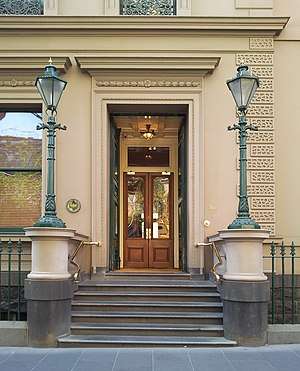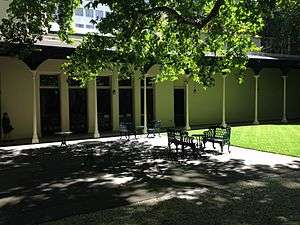Melbourne Club
The Melbourne Club is a private social club established in 1838 and located at 36 Collins Street, Melbourne.


The club is a symbol of Australia's British social heritage and was established at a gathering of 23 gentlemen on Saturday, 17 December 1838, and initially used John Pascoe Fawkner's hotel on the corner of Collins Street and Market Street.[1]
The Melbourne Club moved to new purpose-built premises at the eastern end of Collins Street, designed by Leonard Terry in Renaissance Revival style, in 1859.[2] A dining room wing with a bay window was added at the western end in 1885, designed by Terry and Oakden. It includes, among other rooms, a library, main dining room, private dining room, breakfast room, billiard rooms, lawn room and bedrooms. The building is listed on the Victorian Heritage Register.[2]
At the rear of the Club building is a private courtyard garden, maintained by arborist-horticulturalist John Fordham, which is also listed on the Victorian Heritage Register,[3] and is the location of garden parties and private functions. The garden contains the largest plane tree in Victoria, according to the National Trust's Register of Significant Trees.[3]

The Melbourne Club does not allow female membership.[4] The female-only Lyceum Club, located directly behind in Ridgway Place, enjoys views of the trees of the Melbourne Club's gardens.
Notable members
Frederick Powlett (1811–1865) was a founding member in 1838 as well as being a founding member and the first recorded president of the Melbourne Cricket Club in 1838. He was a public servant, a police magistrate and later chief commissioner of Crown Lands.
Other notable members:
- Governors-General Sir Isaac Isaacs, Sir Ninian Stephen and Rt Rev Hon Peter Hollingworth;
- Governors of Victoria Sir Henry Winneke, Sir James Gobbo and the Hon Alex Chernov;
- Chief Justices of Australia Sir John Latham and Sir Owen Dixon;
- High Court Justices Sir Daryl Dawson and Kenneth Madison Hayne;
- Chief Justices of Victoria Sir William Foster Stawell, Sir William Irvine, Sir Frederick Mann, Sir Edmund Herring, Sir Henry Winneke and Sir John Young;
- Prime Minister Malcolm Fraser;
- Politicians Sir John Bloomfield, Andrew Peacock and Admiral Sir William Bridges;
- Generals Sir Brudenell White and Sir William Johnston;
- Chief Commissioners of Victoria Police Sir William Mitchell, Sir Charles MacMahon and Frederick Standish;[5]
- Artists Sir Arthur Streeton and Sir Daryl Lindsay;
- Prominent businessmen Sir James Balderstone, Hugh Morgan, Don Argus and Kevan Gosper.[6]
See also
References
- McNicoll, Ronald (1988). Number 36 Collins Street (2008 ed.). Australia: Allen & Unwin/Haynes in conjunction with the Melbourne Club. ISBN 978 0 04378 008 4.
- "Melbourne Club". vhd.heritagecouncil.vic.gov.au. Retrieved 22 March 2020.
- Young, Helen (20 February 2016). "Open gardens: Melbourne Club's walled oasis". The Australian. Retrieved 21 February 2016.
- "Men's clubs remain women-free zones". abc.net.au. 25 November 2009. Retrieved 28 November 2017.
- Melbourne Club (1857). Rules and regulations of the Melbourne Club, Victoria. Melbourne : Goodhugh & Hough, Printers.
- "Exclusive clubs feud over highrise plan". ABC Radio. 15 February 2000. Retrieved 24 February 2010.